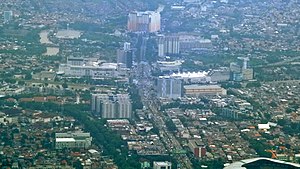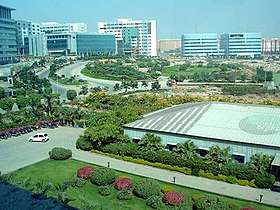Satellite city
Satellite cities or satellite towns are smaller municipalities that are adjacent to a major city which is the core of a metropolitan area.[2][3] They differ from mere suburbs, subdivisions and especially bedroom communities in that they have municipal governments distinct from that of the core metropolis and employment bases sufficient to support their residential populations. Conceptually, satellite cities could be self-sufficient communities outside of their larger metropolitan areas. However, functioning as part of a metropolis, a satellite city experiences cross-commuting (that is, residents commuting out of and employees commuting into the city).
Satellite cities versus other types of settlement
Satellite cities are different from and are sometimes confused with the following related patterns of development.
Suburbs
Satellite cities differ from suburbs in that they have distinct employment bases, commutersheds, and cultural offerings from the central metropolis, as well as an independent municipal government. Satellite cities are not bedroom communities.
Edge cities
Satellite cities differ from edge cities, which are suburbs with large employment bases and cultural offerings, in that satellite cities must have a true historic downtown, a distinct independent municipal government, existed as a city prior to becoming interconnected with the larger metropolitan core, and are surrounded by a belt of rural land between themselves and the central city.
Conceptually, both satellite cities and some types of edge city could be (and once were) self-sufficient communities outside of their larger metropolitan areas, but have become interconnected due to the suburban expansion of the larger metropolis. However, while edge cities may have their own government and share many characteristics with satellite cities, they are much more physically integrated with the core city and would not exist in anything like their present form if not for the suburban expansion of their larger neighbor. Edge cities are activity nodes within a metro area, not miniature metro areas themselves.
Some satellite cities that are particularly close or well connected to their larger neighbors and/or have their own historic downtown may also qualify as the uptown variety of edge cities, but the terms are not synonymous.
Multi-polar cities
In some cases large metropolitan areas have multiple centers of close to equal importance. These multi-polar cities are often referred to as twin cities. Multi-polar cities differ from satellite cities in such cases :
- satellites are clearly much less important than the larger center around which they are located, while the various nodes of multi-polar cities are close to each other in importance
- satellites are separated from the larger center by a substantial belt of rural territory, while twin cities may be fully integrated in physical form
For example, Fort Worth, Texas is a twin of Dallas, Texas because though Fort Worth is somewhat smaller, it is proportionally close enough and physically integrated enough with Dallas to be considered a twin rather than a satellite. However, Waco, Texas is a satellite town of both cities. Generally speaking, cities that are listed as being part of the same urbanized area should be considered twins, rather than one having a satellite relationship to the other.
Metropolitan areas
Conceptually, satellite cities are miniature metro areas on the fringe of larger ones. Satellite cities are sometimes listed as part of the larger metro area, and sometimes listed as totally independent. In the United States, satellite cities are often (but not always) listed as independent Metropolitan Statistical Areas within a single Combined Statistical Area that is unified with the larger metropolis.
Examples
Argentina
- Campana, Buenos Aires Province (satellite of Buenos Aires)
- La Plata (satellite of Buenos Aires)
- Lujan, Buenos Aires Province (satellite of Buenos Aires)
Australia
- Caboolture, Queensland (satellite of Brisbane)
- Ipswich, Queensland (satellite of Brisbane)
- Gawler, South Australia (satellite of Adelaide)
- Melton, Victoria (satellite of Melbourne)
- Sunbury, Victoria (satellite of Melbourne)
- Mandurah, Western Australia (satellite of Perth)
- Palmerston, Northern Territory (satellite of Darwin)
- Pakenham, Victoria (satellite of Melbourne)
- Penrith, New South Wales (satellite of Sydney)
- Queanbeyan, New South Wales (satellite of Canberra)
- Werribee, Victoria (satellite of Melbourne)
Bangladesh
- Purbachal New Town (satellite of Dhaka)[4]
- Uttara Model Town (3rd Phase) (satellite of Dhaka)[4]
Belarus
Brazil
- Jundiaí (satellite of São Paulo)
- Mogi das Cruzes (satellite of São Paulo)
- Niterói (satellite of Rio de Janeiro)
- Olinda (satellite of Recife)
- Santos, São Paulo (satellite of São Paulo)
Cambodia
- Camko City (satellite of Phnom Penh)
Canada
- Mississauga, Ontario (satellite of Toronto)
- Oshawa, Ontario (satellite of Toronto)
- Saint-Jean-sur-Richelieu, Quebec (satellite of Montreal)
- Saint-Jérôme, Quebec (satellite of Montreal)
- Saint-Hyacinthe, Quebec (satellite of Montreal)
- Joliette, Quebec (satellite of Montreal)
- Sorel-Tracy, Quebec (satellite of Montreal)
- Salaberry-de-Valleyfield, Quebec (satellite of Montreal)
- Abbotsford, British Columbia (satellite of Vancouver)
Croatia
- Velika Gorica (satellite of Zagreb)
Egypt
- 6th of October City (satellite of Cairo)
Finland
India
- Gurgaon, Sonepat, Noida, Greater Noida, Ghaziabad and Faridabad (Satellites of Delhi)[5]
- Sanand and Gandhinagar (satellites of Ahmedabad)
- Asansol, West Bengal (satellite of Asansol)
- Salt Lake, New Town, Kolkata West International City, Kalyani, West Bengal, Calcutta Riverside, Sarsuna satellite township and Shakuntala Park Satellite Township (satellites of Kolkata)
- Navi Mumbai, Kalyan-Dombivli, Vasai-Virar, Mira-Bhayander, Thane, Bhivandi, Badlapur, Ambernath and Ulhasnagar (satellites of Mumbai)
- Boduppal, Nizampet, Jawaharnagar, Badangpet, Meerpet-Jillelguda, Bandlaguda Jagir and Peerzadiguda (satellites of Hyderabad)[6]
- Yelahanka and Kengeri (satellites of Bangalore)
- Pimpri-Chinchwad (satellite of Pune)
- Sinnar and Ozar (satellite of Nashik)
- Danapur, Bihta, Fatuha, Punpun, Masaurhi, Maner (satellites of Patna)
- Panchkula and Mohali (satellites of Chandigarh)
- Greater Mohali (satellite of Mohali)
- New Kanpur City (satellite of Kanpur)
- Naya Raipur (satellite of Raipur)
- Bardoli and Sayan (satellites of Surat)
- Kakkanad, Chalakudy, Perumbavoor, Muvattupuzha, Koothattukulam, Koothattukulam, Thodupuzha, Cherthala (satellites of Kochi)
Indonesia
- Bogor (satellite of Jakarta)
- Depok (satellite of Jakarta)
- Tangerang (satellite of Jakarta)
- South Tangerang (satellite of Jakarta)
- Bekasi (satellite of Jakarta)
- Gresik (satellite of Surabaya)
- Bangkalan (satellite of Surabaya)
- Mojokerto (satellite of Surabaya)
- Sidoarjo (satellite of Surabaya)
- Lamongan (satellite of Surabaya)
- Binjai (satellite of Medan)
- Tebing Tinggi (satellite of Medan)
- Kendal (satellite of Semarang)
- Ungaran (satellite of Semarang)
- Salatiga (satellite of Semarang)
- Purwodadi (satellite of Semarang)
- Cimahi (satellite of Bandung)
- Badung (satellite of Denpasar)
- Gianyar (satellite of Denpasar)
- Tabanan (satellite of Denpasar)
- Solo Baru (satellite of Surakarta)
- Maros (satellite of Makassar)
- Gowa (satellite of Makassar)
- Batu (satellite of Malang)
- Tenggarong (satellite of Samarinda)
- Penajam (satellite of Balikpapan)
Israel
Iran
Ireland
- Swords (satellite of Dublin)
- Bray (satellite of Dublin)
- Ballincollig (satellite of Cork City)
- Midleton (satellite of Cork City)
- Cobh (satellite of Cork City)
- Carrigaline (satellite of Cork City)
- Blarney (satellite of Cork City)
- Tower (satellite of Cork City)
Malaysia
- Petaling Jaya (satellite of Kuala Lumpur)
- Bayan Lepas (satellite of George Town)
- Iskandar Puteri (satellite of Johor Bahru)
Mexico
- Ciudad Satélite, literally Satellite City (originally satellite of Mexico City but already absorbed by it)
- Playas de Rosarito, (satellite of Tijuana)
- San Cristóbal Ecatepec, (satellite of Mexico City)
- San Luis Rio Colorado, (satellite of Mexicali)
- Tecate, (satellite of Tijuana)
- Tlajomulco de Zuñiga, (satellite of Guadalajara)
- Tlaquepaque, (satellite of Guadalajara)
- Valle de las Palmas, (satellite of Tijuana)
- Zapopan, (satellite of Guadalajara)
New Zealand
Statistics New Zealand defines a satellite urban community as one where 20 percent or more of the resident population's work in a main urban area (30,000 or more). The following towns meet this criterion:[7]
- Waiheke Island (satellite of Auckland)
- Helensville (satellite of Auckland)
- Pukekohe (satellite of Auckland)
- Waiuku (satellite of Auckland)
- Huntly (satellite of Hamilton)
- Raglan (satellite of Hamilton)
- Te Puke (satellite of Tauranga)
- Waitara (satellite of New Plymouth)
- Inglewood (satellite of New Plymouth)
- Feilding (satellite of Palmerston North)
- Bulls (satellite of Palmerston North)
- Woodville (satellite of Palmerston North)
- Ōtaki (satellite of Kapiti and Wellington)
- Featherston (satellite of Wellington)
- Wakefield (satellite of Nelson)
- Brightwater (satellite of Nelson)
- Rangiora (satellite of Christchurch)
- Woodend (satellite of Christchurch)
- Lincoln (satellite of Christchurch)
- Rolleston (satellite of Christchurch)
- Darfield (satellite of Christchurch)
- Leeston (satellite of Christchurch)
- Riverton (satellite of Invercargill)
Pakistan
- Satellite Town, Gujranwala (satellite of Gujranwala)
- Satellite Town, Rawalpindi (satellite of Rawalpindi)
- Satellite Town Mirpurkhas (satellite of Mirpurkhas)
Poland
Serbia
- Pančevo (satellite of Belgrade)
- Sremski Karlovci (satellite of Novi Sad)
- Lebane (satellite of Leskovac)
Singapore
- Ang Mo Kio (satellite of the Central Area)
- Bedok (satellite of the Central Area)
- Bishan (satellite of the Central Area)
- Bukit Batok (satellite of the Central Area)
- Bukit Merah (satellite of the Central Area)
- Bukit Panjang (satellite of the Central Area)
- Choa Chu Kang (satellite of the Central Area)
- Clementi (satellite of the Central Area)
- Hougang (satellite of the Central Area)
- Jurong (satellite of the Central Area)
- Pasir Ris (satellite of the Central Area)
- Punggol (satellite of the Central Area)
- Queenstown (satellite of the Central Area)
- Sembawang (satellite of the Central Area)
- Sengkang (satellite of the Central Area)
- Serangoon (satellite of the Central Area)
- Tampines (satellite of the Central Area)
- Toa Payoh (satellite of the Central Area)
- Woodlands (satellite of the Central Area)
- Yishun (satellite of the Central Area)
Taiwan

.jpg)
- Banqiao, Luzhou, Sanchong, Shulin, Tamsui, Tucheng, Xindian, Xinzhuang, Xizhi, Yonghe and Zhonghe in New Taipei (satellites of Taipei)
- Keelung (satellite of Taipei)
- Bade, Guishan, Luzhu, Pingzhen and Yangmei in Taoyuan City (satellites of Taoyuan District and Zhongli)
- Zhubei, Hsinchu County (satellite of Hsinchu)
- Dali, Fengyuan, Taiping and Tanzi in Taichung (satellites of downtown Taichung)
- Changhua City (satellite of Taichung)
- Yongkang in Tainan (satellite of downtown Tainan)
- Daliao, Fengshan and Gangshan in Kaohsiung (satellites of downtown Kaohsiung)
Turkey
Satellites of İstanbul:
- Ataköy
- Ataşehir
- Bahçeşehir
- Beylikdüzü
- Kayaşehir
- Mimaroba
- Sinanoba
Satellites of Ankara:
Satellite of İzmir:
- Mavişehir
United Kingdom
- Aldershot (satellite of London)
- Barry (satellite of Cardiff)
- Basildon (satellite of London)
- Brentwood (satellite of London)
- Birkenhead (satellite of Liverpool)
- Crawley (satellite of London)
- Chelmsford (satellite of London)
- Eastleigh (satellite of Southampton)
- Grays (satellite of London)
- High Wycombe (satellite of London)
- Kirkintilloch (satellite of Glasgow)
- Long Eaton (satellite of Nottingham)
- Loughborough (satellite of Leicester)
- Luton (satellite of London)
- Maidenhead (satellite of London)
- Mansfield (satellite of Nottingham)
- Medway (satellite of London)
- Musselburgh (satellite of Edinburgh)
- Newtownards (satellite of Belfast)
- Reading (satellite of London)
- Redditch (satellite of Birmingham)
- Redhill (satellite of London)
- Reigate (satellite of London)
- Runcorn (satellite of Liverpool)
- Sevenoaks (satellite of London)
- Skelmersdale (satellite of Liverpool)
- Slough (satellite of London)
- Southend-on-Sea (satellite of London)
- Tamworth (satellite of Birmingham)
- Watford (satellite of London)
- Warrington (satellite of Liverpool and Manchester)
United States
- Aiken, South Carolina (satellite of Augusta, Georgia)
- Allentown, Pennsylvania (satellite of Philadelphia and New York City)
- Alton, Illinois (satellite of St. Louis)
- Anderson, Indiana (satellite of Indianapolis)
- Ann Arbor, Michigan (satellite of Detroit)
- Annapolis, Maryland (satellite of Baltimore and Washington, D.C.)
- Athens, Georgia (satellite of Atlanta)
- Atlantic City, New Jersey (satellite of Philadelphia)
- Auburn, Alabama (satellite of Columbus, Georgia)
- Aurora, Illinois (satellite of Chicago)
- Bainbridge, Georgia (satellite of Tallahassee)
- Battle Creek, Michigan (satellite of Kalamazoo)
- Bethlehem, Pennsylvania (satellite of Philadelphia and New York City)
- Boulder, Colorado (satellite of Denver)
- Bowling Green, Ohio (satellite of Toledo)
- Brentwood, California (satellite of San Francisco)
- Bridgeport, Connecticut (satellite of New York City)
- Burlington, North Carolina (satellite of Greensboro)
- Camden, New Jersey (satellite of Philadelphia)
- Canton, Ohio (satellite of Cleveland and Akron)
- Cedar Park, Texas (satellite of Austin)
- Chester, Pennsylvania (satellite of Philadelphia)
- Cleveland, Tennessee (satellite of Chattanooga)
- Coeur d'Alene, Idaho (satellite of Spokane)
- Columbia, Tennessee (satellite of Nashville)
- Dalton, Georgia (satellite of Chattanooga)
- Daytona Beach, Florida (satellite of Orlando)
- Decatur, Alabama (satellite of Huntsville).
- DeKalb, Illinois (satellite of Chicago)
- Denton, Texas (satellite of Dallas and Fort Worth)
- Eau Claire, Wisconsin (satellite of Minneapolis-Saint Paul)
- Elgin, Illinois (satellite of Chicago)
- Elizabethtown, Kentucky (satellite of Louisville)
- Elkhart, Indiana (satellite of South Bend)
- Elyria, Ohio (satellite of Cleveland)
- Escondido, California (satellite of San Diego)
- Everett, Washington (satellite of Seattle)
- Fall River, Massachusetts (satellite of Boston and Providence)
- Flint, Michigan (satellite of Detroit)
- Fond du Lac, Wisconsin (satellite of Milwaukee)
- Fort Lauderdale, Florida (satellite of Miami)
- Frankfort, Kentucky (satellite of Lexington)
- Franklin, Tennessee (satellite of Nashville)
- Frederick, Maryland (satellite of Baltimore and Washington, D.C.)
- Fredericksburg, Virginia (satellite of Washington, D.C.)
- Gainesville, Georgia (satellite of Atlanta)
- Galveston, Texas (satellite of Houston)
- Gary, Indiana (satellite of Chicago)[8]
- Gastonia, North Carolina (satellite of Charlotte)
- Georgetown, Kentucky (satellite of Lexington)
- Glen Falls, New York (satellite of Albany)
- Grand Haven, Michigan (satellite of Grand Rapids)
- Grants Pass, Oregon (satellite of Medford)
- Greeley, Colorado (satellite of Denver)
- Greensburg, Pennsylvania (satellite of Pittsburgh)
- Hamilton, Ohio (satellite of Cincinnati)
- Hammond, Louisiana (satellite of Baton Rouge and New Orleans)
- Hanford, California (satellite of Fresno)
- Hartford, Connecticut (satellite of Springfield)
- High Point, North Carolina (satellite of Greensboro)
- Hinesville, Georgia (satellite of Savannah)
- Holland, Michigan (satellite of Grand Rapids)
- Janesville, Wisconsin (satellite of Madison)
- Joliet, Illinois (satellite of Chicago)
- Kenosha, Wisconsin (satellite of Chicago and Milwaukee)
- Kingston, New York (satellite of New York City)
- Kissimmee, Florida (satellite of Orlando)
- La Porte, Indiana (satellite of Chicago)
- Lake Havasu City, Arizona (satellite of Las Vegas)
- Las Cruces, New Mexico (satellite of El Paso)
- Lawrence, Kansas (satellite of Kansas City)
- Lebanon, Pennsylvania (satellite of Harrisburg)
- Lewiston, Maine (satellite of Portland)
- Liberty, Missouri (satellite of Kansas City)
- Longview, Washington (satellite of Portland)
- Lorain, Ohio (satellite of Cleveland)
- Lowell, Massachusetts (satellite of Boston)
- Madera, California (satellite of Fresno)
- Manchester, New Hampshire (satellite of Boston)
- Marietta, Ohio (satellite of Parkersburg, West Virginia)
- Marshall, Texas (satellite of Shreveport)
- Maysville, Kentucky (satellite of Cincinnati)
- Melbourne, Florida (satellite of Orlando)
- Mentor, Ohio (satellite of Cleveland)
- Merced, California (satellite of Modesto)
- Michigan City, Indiana (satellite of Chicago)
- Middletown, Ohio (satellite of Cincinnati)
- Monroe, Michigan (satellite of Detroit and Toledo)
- Morgantown, West Virginia (satellite of Pittsburgh)
- Morristown, Tennessee (satellite of Knoxville)
- Muncie, Indiana (satellite of Indianapolis)
- Murfreesboro, Tennessee (satellite of Nashville)
- Muskegon, Michigan (satellite of Grand Rapids)
- Napa, California (satellite of San Francisco)
- Naples, Florida (satellite of Cape Coral and Fort Myers)
- Nashua, New Hampshire (satellite of Boston)
- New Bedford, Massachusetts (satellite of Providence)
- New Braunfels, Texas (satellite of San Antonio)
- New Haven, Connecticut (satellite of New York City)
- Newark, New Jersey (satellite of New York City)
- Newburgh, New York (satellite of New York City)
- Newnan, Georgia (satellite of Atlanta)
- Newport, Rhode Island (satellite of Providence)
- Niagara Falls, New York (satellite of Buffalo)
- Norman, Oklahoma (satellite of Oklahoma City)
- Norwich, Connecticut (satellite of Hartford)
- Oceanside, California (satellite of San Diego)
- Ogden, Utah (satellite of Salt Lake City)
- Olympia, Washington (satellite of Seattle)
- Oswego, New York (satellite of Syracuse)
- Ottawa, Illinois (satellite of Chicago)
- Owensboro, Kentucky (satellite of Evansville)
- Oxnard, California (satellite of Los Angeles)
- Petersburg, Virginia (satellite of Richmond)
- Pine Bluff, Arkansas (satellite of Little Rock)
- Port Huron, Michigan (satellite of Detroit)
- Poughkeepsie, New York (satellite of New York City)
- Providence, Rhode Island (satellite of Boston)
- Provo, Utah (satellite of Salt Lake City)
- Punta Gorda, Florida (satellite of Sarasota)
- Racine, Wisconsin (satellite of Milwaukee)
- Ravenna, Ohio (satellite of Akron)
- Reading, Pennsylvania (satellite of Philadelphia),
- Richmond, Kentucky (satellite of Lexington)
- Riverside, California (satellite of Los Angeles)
- Rock Hill, South Carolina (satellite of Charlotte)
- Rockford, Illinois (satellite of Chicago)
- Round Rock, Texas (satellite of Austin)
- Ruston, Louisiana (satellite of Monroe)
- Saint Augustine, Florida (satellite of Jacksonville)
- Saint Cloud, Minnesota (satellite of Minneapolis-Saint Paul)
- Salem, Oregon (satellite of Portland)
- San Bernardino, California (satellite of Los Angeles)
- San Marcos, Texas (satellite of Austin)
- Sandusky, Ohio (satellite of Cleveland and Toledo)
- Santa Cruz, California (satellite of San Jose)
- Santa Fe, New Mexico (satellite of Albuquerque)
- Santa Rosa, California (satellite of San Francisco)
- Schenectady, New York (satellite of Albany)
- Sheboygan, Wisconsin (satellite of Milwaukee)
- Springfield, Ohio (satellite of Dayton)
- Tacoma, Washington (satellite of Seattle)
- Texarkana, Arkansas/Texas (satellite of Shreveport)
- Trenton, New Jersey (satellite of Philadelphia and New York City)
- Tuscaloosa, Alabama (satellite of Birmingham)
- Tyler, Texas (satellite of Dallas)
- Vallejo, California (satellite of San Francisco)
- Valparaiso, Indiana (satellite of Chicago)
- Vancouver, Washington (satellite of Portland)
- Vineland, New Jersey (satellite of Philadelphia)
- Walla Walla, Washington (satellite of the Tri-Cities)
- Warner Robins, Georgia (satellite of Macon)
- Waterbury, Connecticut (satellite of New York City)
- Waukegan, Illinois (satellite of Chicago)
- Wendell, North Carolina (satellite of Raleigh)
- West Palm Beach, Florida (satellite of Miami)
- Williamsburg, Virginia (satellite of Norfolk, Virginia)
- Wilmington, Delaware (satellite of Philadelphia)
- Wilmington, Ohio (satellite of Cincinnati)
- Worcester, Massachusetts (satellite of Boston)
- Youngstown, Ohio (satellite of Pittsburgh and Cleveland)
- Yuba City, California (satellite of Sacramento)
Vietnam
See also
- General
- Rural exodus
- New Urbanism
- Urban sprawl
- Bedroom community
- Edge city
- Urban area
- United States urban area
- Planning
References
- https://megapolitan.kompas.com/read/2013/11/01/0834060/Kota.Satelit.Sumbang.Kemacetan.Jakarta.Setiap.Hari?page=all
- Goldfield, David (2007). Encyclopedia of American Urban History. ISBN 9780761928843.
- Shao, Zisheng (19 August 2015). The New Urban Area Development: A Case Study in China. ISBN 9783662449585.
- Mahmud, Abu Hayat (26 January 2014). "Rajuk's big projects facing several hurdles". Dhaka Tribune. Retrieved 13 January 2016.
- "NCR Region of Delhi: Gurgaon, sonepat, Noida, Faridabad & Ghaziabad Shakuntala Parkwork=delhicapital.com". Archived from the original on 8 March 2012. Retrieved 1 March 2012.
- "Telangana State to add 7 new municipal corporations to existing 6". The Hans India. Retrieved 13 May 2020.
- "New Zealand: An Urban/Rural Profile" (PDF). Statistics New Zealand. Retrieved 26 June 2015.
- Lane, James B. (1978). City of the Century: A History of Gary, Indiana. Indiana University Press. p. 27. ISBN 0253111870.
External articles
- Graham Romeyn Taylor, Satellite Cities. A Study of Industrial Suburbs. ISBN 1-4021-6188-3
- Berger, A. S. (1978). The city: urban communities and their problems. Dubuque, Iowa: Brown.
- Carpenter, N. (1931). The sociology of city life. Longmans' social science series. New York: Longmans, Green and Co.




